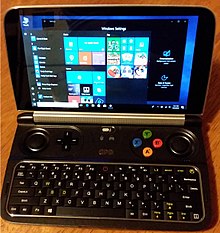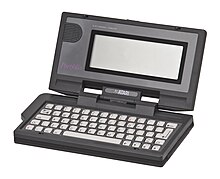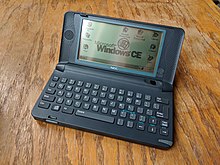Handheld PC
This article needs to be updated. The reason given is: Does not cover recent topics past year 2005, like GPD or Ryzen Z1. (July 2023) |

A handheld personal computer (PC), typically built around either a
Until recently, most handheld PCs used an
The name Handheld PC was used by
History

The first hand-held device compatible with desktop IBM personal computers of the time was the
Today, most modern Handheld PCs are designed around portable gaming. And due to the popularity of the
Microsoft's Handheld PC standard


The Handheld PC (with capital "H") or H/PC for short was the official name of a hardware design for
Microsoft was wary of using the term "PDA" for the Handheld PC. Instead, Microsoft marketed this type of device as a "PC companion".[2][3]
To be classed as a Windows CE Handheld PC, the device must:[4]
- Run Microsoft's Windows CE
- Be bundled with an application suite only found through an OEM Platform Release and not in Windows CE itself
- Use ROM
- Have a screensupporting a resolution of at least 480×240
- Include a keyboard (except tablet models)
- Include a PC cardslot
- Include an infrared (IrDA) port
- Provide wired Universal Serial Bus(USB) connectivity
In 1998, Microsoft released the Palm-size PC, which have smaller screen sizes and lack keyboards compared to Handheld PC. Palm-size PC became Pocket PC in 2000.
Due to limited success of Handheld PC, Microsoft focused more on the keyboard-less Pocket PC. In September 2000, the updated Handheld PC 2000 was announced which is based on version 3.0 of Windows CE.[5] Interest in the form factor overall quickly evaporated, and by early 2002 Microsoft were no longer working on Handheld PC, with its distinct functionality removed from version 4.0 of Windows CE.[3] HP and Sharp both discontinued their Windows CE H/PCs in 2002, while NEC was last to leave the market in 2005. However, some manufacturers abandoned the format even before Microsoft did, such as Philips and Casio.
See also
References
- ^ "HP Virtual Museum: Hewlett-Packard 95LX computer, 1991". www.hp.com. Retrieved 2020-09-09.
- ^ "The Spectacular Failure of WinCE and Windows Mobile". www.roughlydrafted.com. Retrieved 2021-04-24.
- ^ a b "The history of Windows CE - thisishenry168". sites.google.com. Retrieved 2021-04-24.
- ^ Tilley, Chris (2001-02-18). "The History of Windows CE: Windows CE 1". HPC:Factor. Retrieved 2007-04-20.
- ^ Brewin, Bob (2000-09-07). "Microsoft tries again with Handheld PC". Computerworld. Retrieved 2021-04-24.
